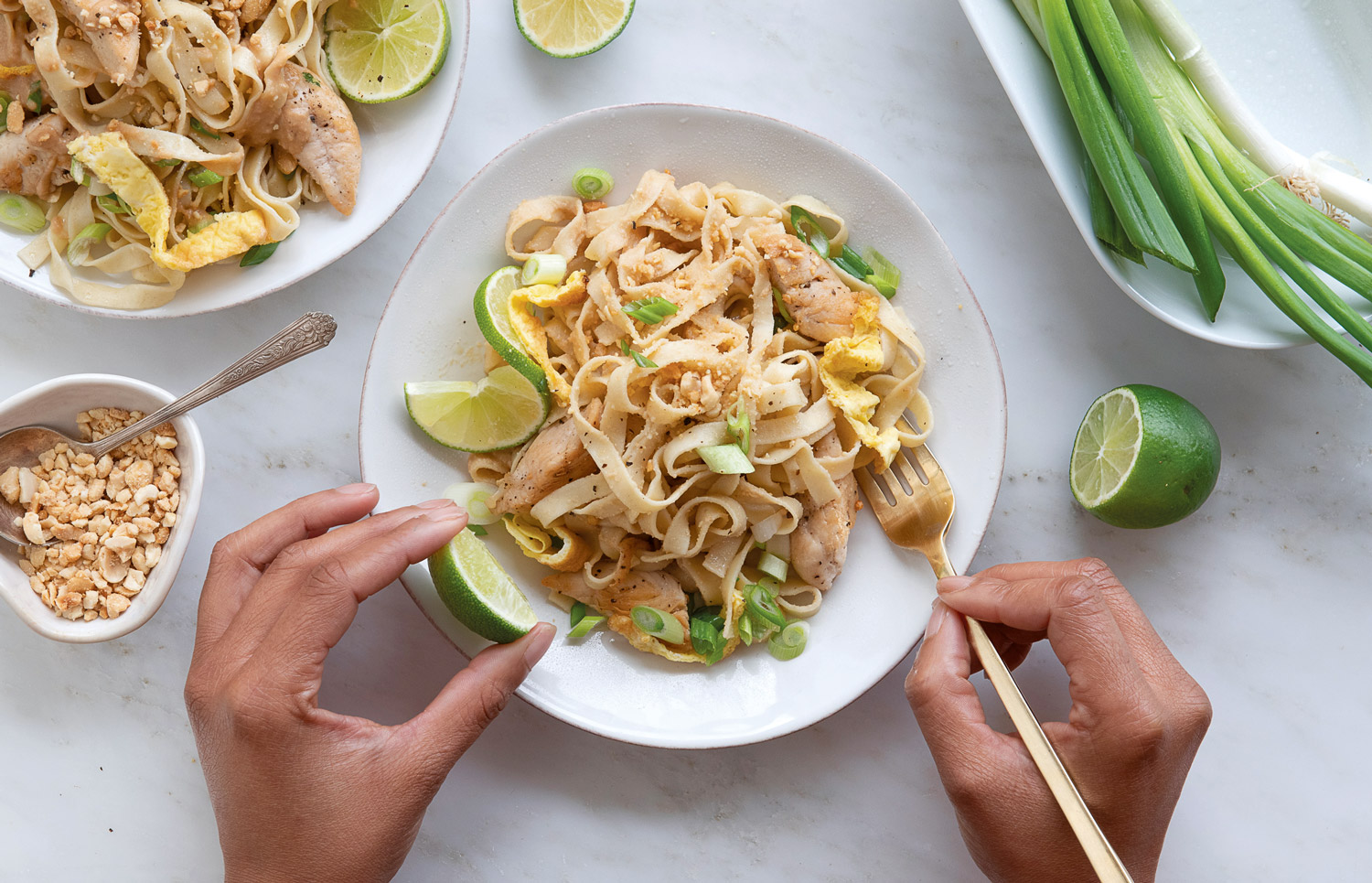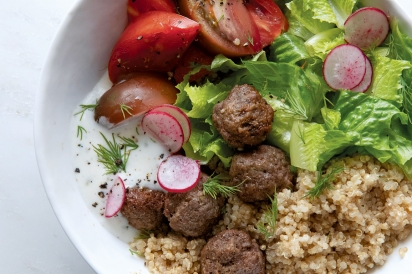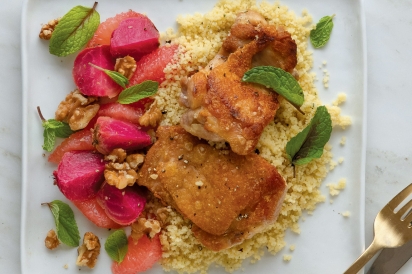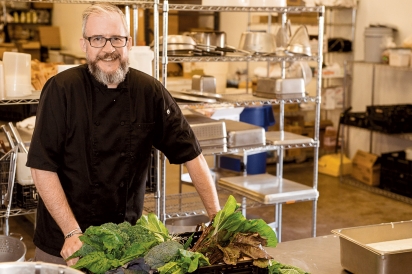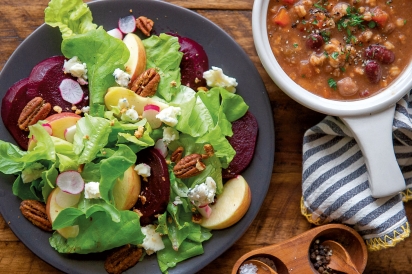Thinking Inside the Meal Delivery Box
Long gone are days of leafing through grease-stained cookbooks to get dinner on the table. Since the rise of meal-kit delivery services like the nationally renowned Blue Apron and locally trusted Farmhouse Delivery, home cooks have discovered reliable inspiration for creating fresh, worldly meals in a gourmet fashion.
But aside from offering time and budget management through their weekly meal deliveries, these culinary services have also inspired a host of healthy life habits, including nutritional balance, access to local and sustainable ingredients, food waste reduction and inspiring a less-stressful habit of home cooking.
Despite earning a degree in international politics, John Adler, director of culinary for Blue Apron, has spent his whole professional career in the food world, working for restaurants like Franny’s in Brooklyn, NY. Adler’s first love, however, has always been the home kitchen.
“The more I worked in restaurants and spoke to people the more I realized people do want to cook more at home. They know it’s healthier and they want that sense of control over their lives, but it all becomes daunting very quickly when you say to someone, ‘You need to buy a bunch of parsley when you only need a little bit for one recipe,’ or ‘You need to buy this $10 jar of harissa to make one Middle Eastern dish,’” he says. “In doing that, you create these incredibly anxious moments for people. It’s a large part of what holds people back in home cooking.”
Adler accepted his position at Blue Apron in 2016, and during his time at the company the chef has seen the meal-kit service revise its approach to whole wellness, including adjusting their view of nutritional balance. Adler says the company had just launched nutritional guardrails (basic nutritional/caloric expectations) when he joined the team, which at the time allowed dishes to fall between 600 to 800 calories per serving. However, what the company realized along the way was that diners weren’t as fixated on nutritional boundaries as originally believed.
“We started with strict thresholds for nutrient expectations. Over time, and this is one of the beautiful things about a product that changes weekly, we heard from customers that they wanted an indulgent dinner every now and then. [They’d say], ‘I don’t need my cheeseburger to be 800 calories and I’m not really thinking about too much saturated fat. It’s a cheeseburger; I know what I’m getting myself into.’ That was their way of saying, ‘Don’t patronize me, and don’t try and make this something that it isn’t. Let cheeseburgers be cheeseburgers, but maybe be thoughtful about a grain bowl or chicken with kale.’”
With that in mind, the company has evolved its accommodation of various dietary lifestyles, now embracing dishes that range from 350 to 990 calories per portion. Most recently, the company partnered with WW—formerly Weight Watchers—to allow diners to select from various dietary approaches that best fit their nutritional lifestyles at any given time.
“One reason we went after the partnership with WW and one of the reasons I’ve been so excited about this partnership is our philosophies in so many ways are the exact same: It’s all about balance,” he says.
Much like Adler, Matt Taylor, chef at Austin-based Farmhouse Delivery, transitioned from the fine-dining world. After leaving Austin’s famed Swift’s Attic, Taylor longed to return to his roots of fresh, organic produce— something he cultivated as a stocker at a natural foods grocery store early in his career. That’s when the opportunity to join Farmhouse Delivery a year and a half ago came around. It was a calling that Taylor could not resist.
In preparing the 1,500 to 1,600 portions that go out each week in the Farmhouse Delivery meal kits, Taylor selects ingredients from an array of Texas-based farmers, ranchers and artisans, including numerous selections in or around Houston, such as Slow Dough Bread Co., Gulf Pacific Rice, Rose’s Seafood, Utility Research Garden and Thrive Ibericus Pig Farm. Taylor says Farmhouse hopes to inspire customers to fall in love with wholesome eating through providing locally sourced, sustainable ingredients for the home kitchen.
“Our group is very veggie-centric. It’s a lifestyle not only to eat your veggies, but to make sure your produce, your meats and your proteins come from a good source. The more you do that, the better you’re going to feel. We share that mission with anyone who wants to eat cleaner,” he says.
Farmhouse Delivery also understands one palate does not fit all. That’s why the company offers at least two gluten-free options, one elimination-diet option (eliminating specific food groups) and one vegetarian option each week in their meal kits, drawing from an assortment of global cuisines, including Thai, New American, Vietnamese, Mexican and more.
Taylor admits that what inspires him most about Farmhouse Delivery is the ease the company has bestowed to its consumers. “I believe with a good cast-iron skillet, sauté pan and sheet pan you can create almost anything, and we are introducing simple, timetested techniques,” he says. “We believe in empowering people to cook something that tastes good, is easy to get on the table and is really healthy for families.”
In addition to adding wholesome ingredients to her family meals, one of the reasons Shelly deZevallos decided to bring Farmhouse Delivery meal kits into her household was to cut down on food waste and support Texas farmers.
“You get to know these families who are raising these [ingredients] and you see how hard they work to bring to life these fresh fruits, vegetables, meats and pastries. I can’t imagine wasting what I consider a labor of love on their behalf,” she says. “They create something we often miss out on at a traditional grocery store: great holistic foods, freshly grown for everybody.”
The most important wellness benefit for the West Houston Airport pilot and mother of two, however, is the time she saves in allowing Farmhouse to take the reins in her kitchen.
“There are two things in life you can never replace: time and people,” she says. “Farmhouse takes that stress away from me. I don’t have to find a new recipe, I don’t have to see if it works well and I get to spend quality time with my family. Removing stress is absolutely a wellness benefit in today’s busy world. Farmhouse helps families, and they also help people like us who wish they could live on a farm every day of their lives.”
And though the Farmhouse meal kits are designed to eliminate the hard work that goes into cooking, Taylor has a rather surprising goal in mind for Farmhouse’s customers: “In the back of my mind when I’m writing these recipes I have this hope that I’m teaching people how to cook so they take what they’ve learned and apply it on their own.”
Farmhouse Delivery uses various methods to reduce both their packaging and food waste.
Instead of shipping their weekly meal subscriptions in bulky cardboard boxes and multiple plastic bags, Farmhouse Delivery enlists reusable insulated bags and bright green delivery bins that customers then return to the company for reuse. In addition to this environmentally friendly packaging, Farmhouse uses frozen water bottles to keep their meal kits cool until delivery. Customers are also encouraged to return or donate water bottles for reuse in the kits as well.
“All of these measures are used in lieu of what some of the national meal-kit brands utilize, [like] disposable cardboard boxes, disposable dry ice packs and Styrofoam containers,” says Lisa Tridle, marketing and events manager at Farmhouse Delivery.
Another way the company cuts down on packaging waste is to pre-prepare their multi-ingredient items ahead of time for their subscribers. This action saves time and also reduces the company’s carbon footprint.
“Other meal-kit brands will package individual ingredients for the customer to make, like a sauce or a vinaigrette. So if there are six ingredients, each ingredient will get individual plastic packaging,” Tridle says. “However, our meal kits come with sauces, vinaigrettes [and other items] that are already prepared by our chefs. So, for example, instead of six containers with each of the six ingredients, we send one that contains the prepared item.”
Perhaps Farmhouse’s most impressive commitment, though, is food waste reduction. According to Tridle, Farmhouse’s excess food goes to one of four places: meal kits, Farmhouse Kitchen grocery products, into compost or donated to various charitable organizations. In 2018 Farmhouse Delivery donated 9,700 pounds of food to entities like Save the Food, Brighter Bites, Central Texas Food Bank and more.


